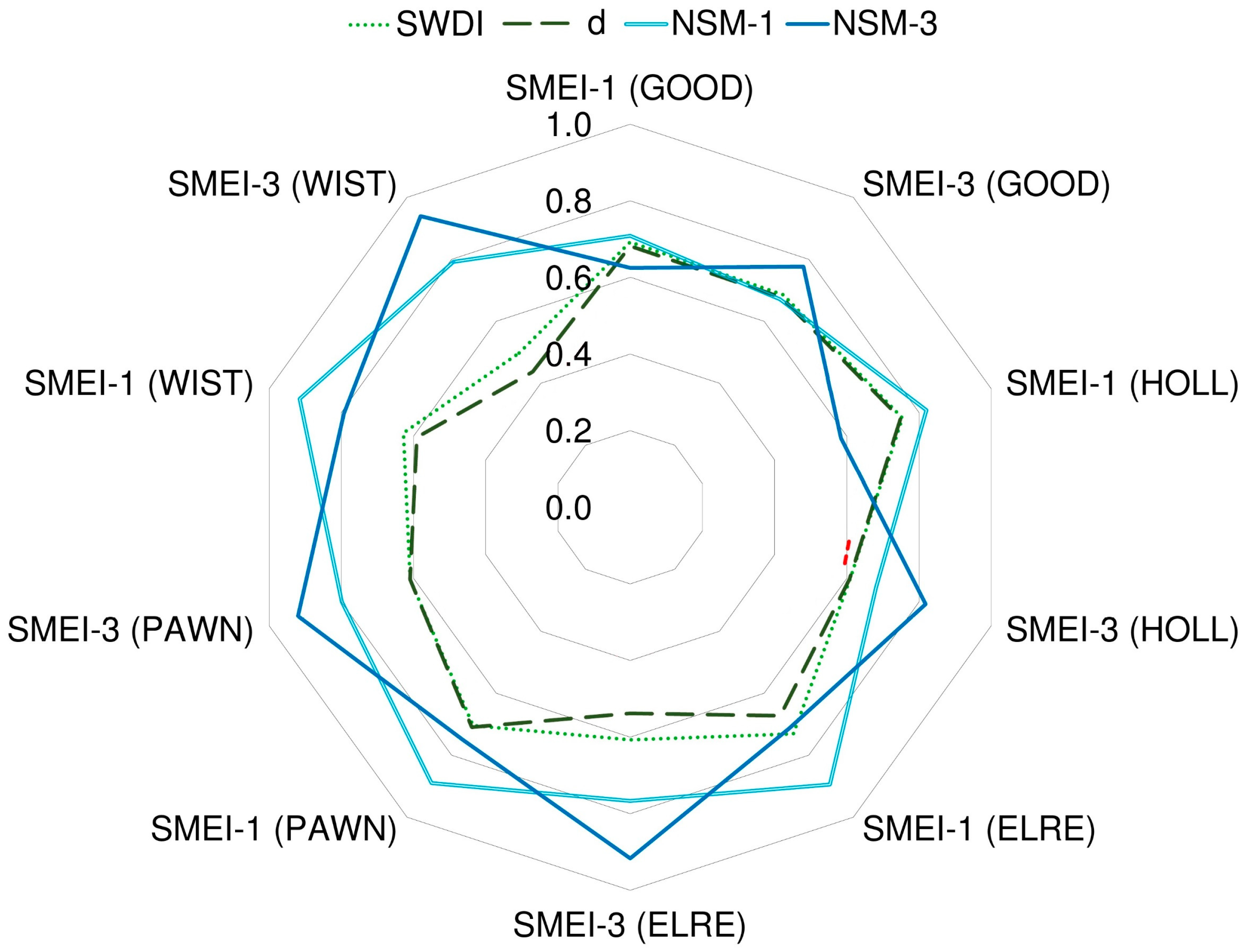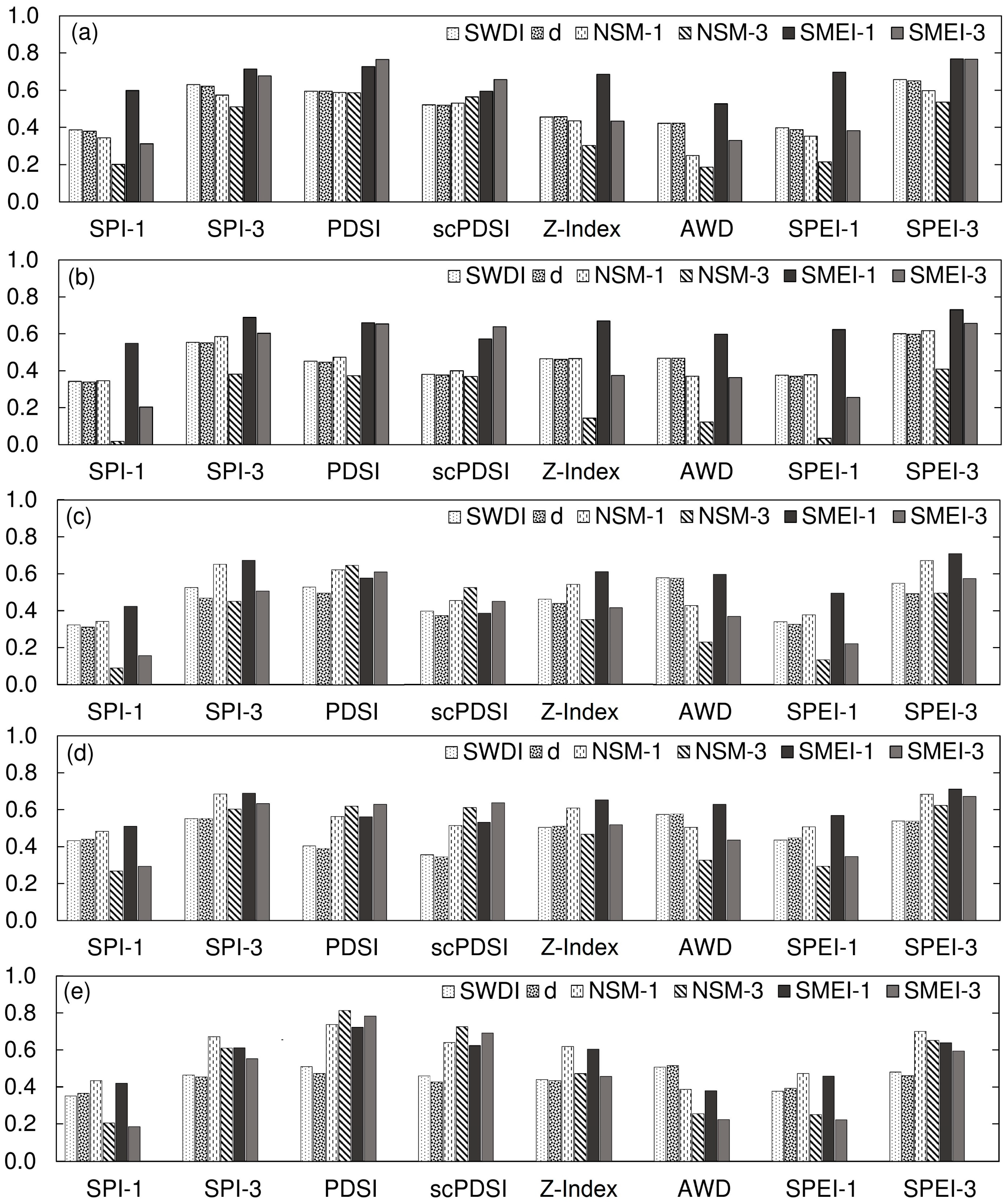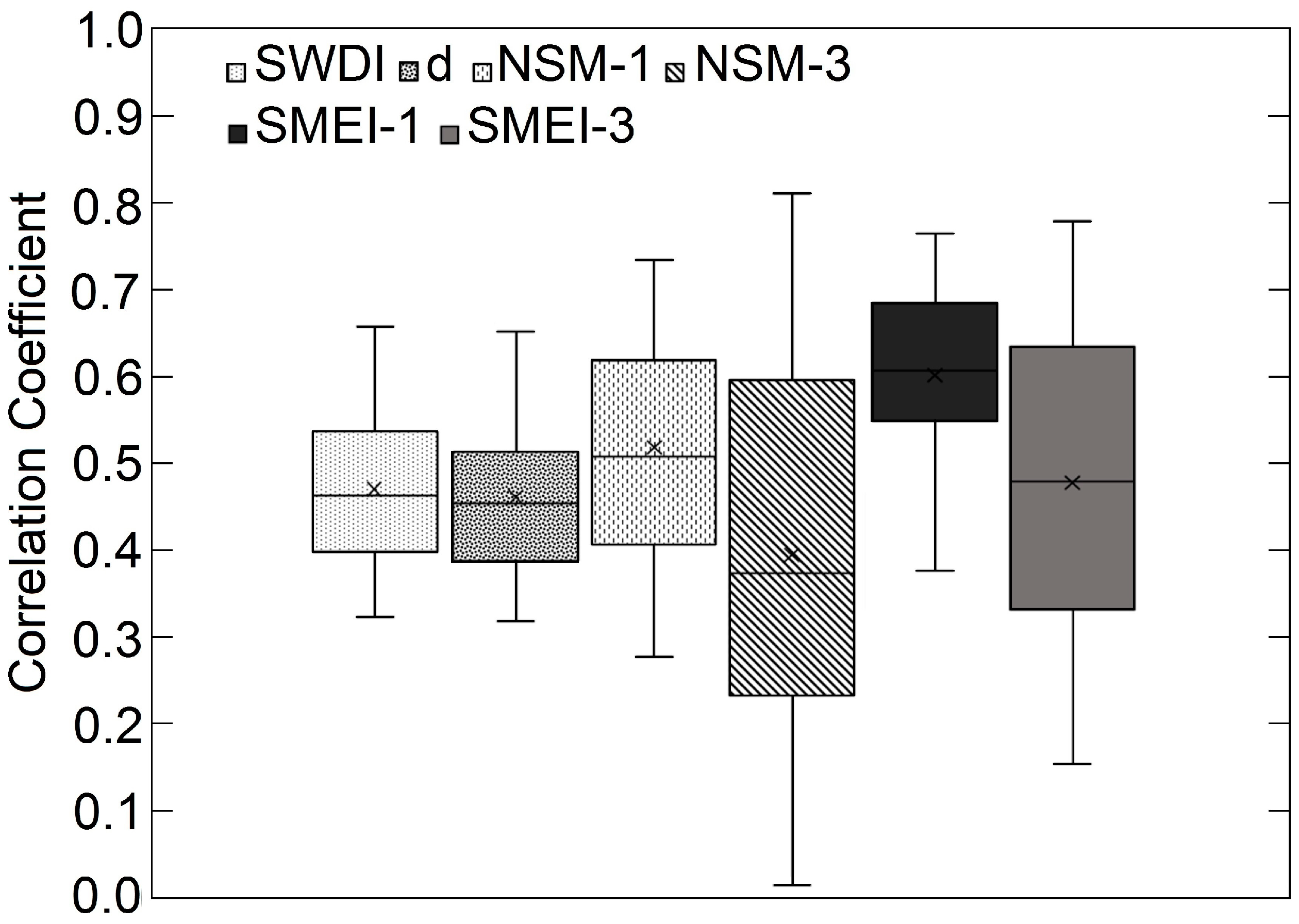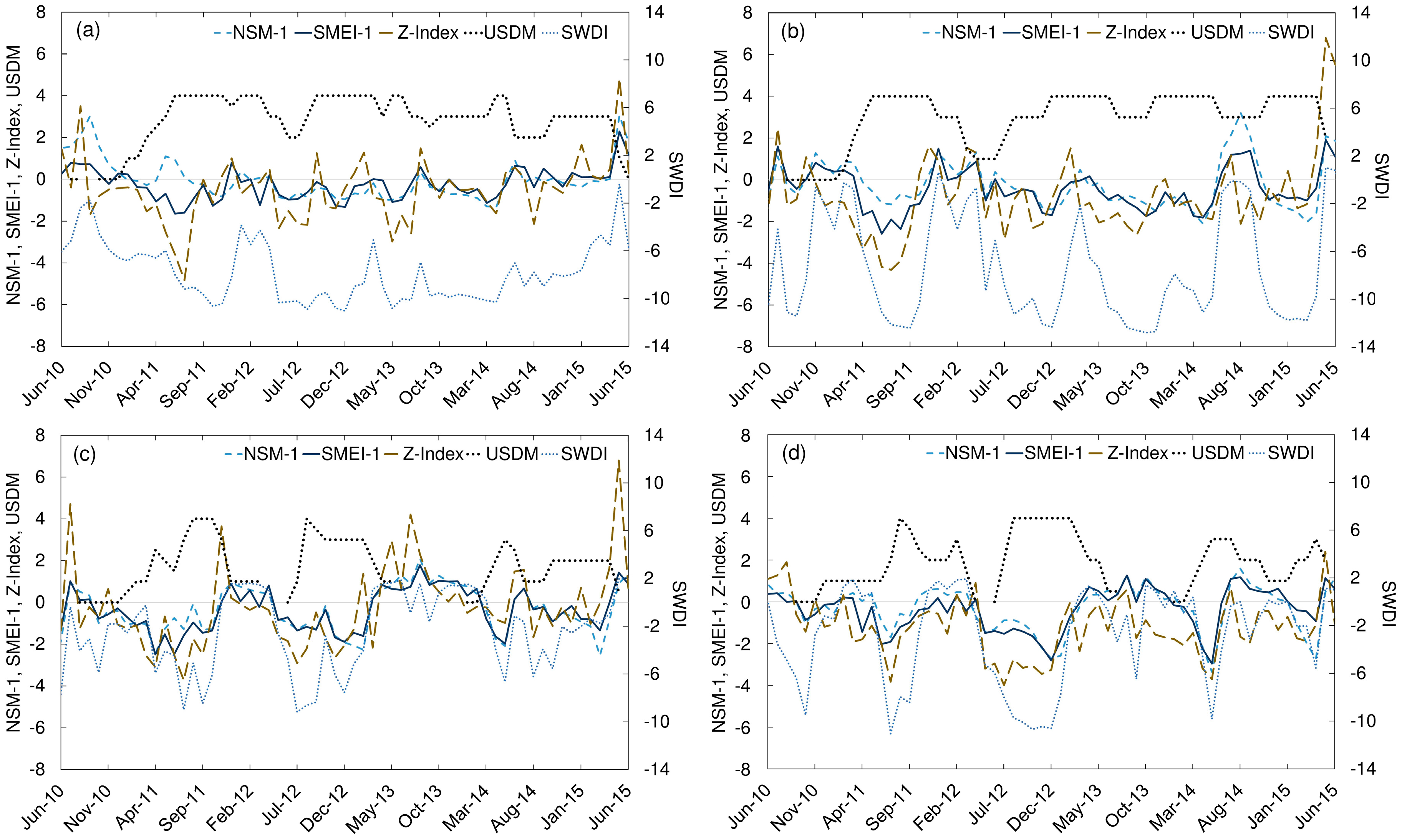Development and Evaluation of an Agricultural Drought Index by Harnessing Soil Moisture and Weather Data
Abstract
1. Introduction
2. Materials and Methods
2.1. Study Sites
2.2. Input Data
2.3. Soil Moisture Based Drought Indices
2.3.1. Soil Water Deficit Index
2.3.2. Water Deficit Index
2.3.3. Normalized Soil Moisture
2.3.4. Soil Moisture Evapotranspiration Index
2.4. Meteorological Drought Indices
2.4.1. Atmospheric Water Deficit
2.4.2. Standardized Precipitation Index
2.4.3. Palmer’s Z-Index
2.4.4. Palmer Drought Severity Index
2.4.5. Self-Calibrated PDSI
2.4.6. Standardized Precipitation Evapotranspiration Index
2.4.7. U.S. Drought Monitor
2.5. Performance Analysis
3. Results and Discussion
3.1. Comparison with SM Indices
3.2. Comparison with Meteorological Indices
3.3. Temporal Tracking of Drought
3.4. Spatial Tracking of Drought
3.5. Comparison with Crop Production
4. Conclusions
Author Contributions
Funding
Acknowledgments
Conflicts of Interest
References
- Taghvaeian, S.; Fox, G.; Boman, R.; Warren, J. Evaluating the impact of drought on surface and groundwater dependent irrigated agriculture in western Oklahoma. In Proceedings of the 2015 ASABE/IA Irrigation Symposium: Emerging Technologies for Sustainable Irrigation, Long Beach, CA, USA, 10–12 November 2015; ASABE: St. Jospeh, MI, USA, 2015; pp. 1–8. [Google Scholar]
- Khand, K.; Taghvaeian, S.; Ajaz, A. Drought and Its Impact on Agricultural Water Resources in Oklahoma. Oklahoma Coop Ext Ser.; Oklahoma State University: Stillwater, OK, USA, 2017; Available online: http://pods.dasnr.okstate.edu/docushare/dsweb/Get/Document-10705/BAE-1533web.pdf (accessed on 5 January 2018).
- Reilly, J.; Tubiello, F.; McCarl, B.; Abler, D.; Darwin, R.; Fuglie, K.; Mearns, L. U.S. agriculture and climate change: New results. Clim. Change 2003, 57, 43–67. [Google Scholar] [CrossRef]
- Rosenzweig, C.; Hillel, D. The Dust Bowl of the 1930s: Analog of greenhouse effect in the Great Plains? J. Environ. Qual. 1993, 22, 9–22. [Google Scholar] [CrossRef]
- Mishra, A.K.; Singh, V.P. A review of drought concepts. J. Hydrol. 2010, 391, 202–216. [Google Scholar] [CrossRef]
- Hayes, M.; Svoboda, M.; Wall, N.; Widhalm, M. The lincoln declaration on drought indices: Universal meteorological drought index recommended. Bull. Am. Meteorol. Soc. 2011, 92, 485–488. [Google Scholar] [CrossRef]
- Moorhead, J.E.; Marek, G.W.; Gowda, P.H.; Marek, T.H.; Porter, D.O.; Singh, V.P.; Brauer, D.K. Exceedance probability of the standardized precipitation-evapotranspiration index in the Texas High Plains. Agric. Sci. 2017, 8, 783–800. [Google Scholar] [CrossRef][Green Version]
- Zargar, A.; Sadiq, R.; Naser, B.; Khan, F.I. A review of drought indices. Environ. Rev. 2011, 19, 333–349. [Google Scholar] [CrossRef]
- Wang, A.; Lettenmaier, D.P.; Sheffield, J. Soil moisture drought in China, 1950–2006. J. Clim. 2011, 24, 3257–3271. [Google Scholar] [CrossRef]
- Mannocchi, F.; Todisco, F.; Vergni, L. Agricultural Drought: Indices, Definition and Analysis. Basis Civ. Water Sci. 2004, 286, 246–254. Available online: http://hydrologie.org/redbooks/a286/iahs_286_0246.pdf (accessed on 12 September 2018).
- Martínez-Fernández, J.; González-Zamora, A.; Sánchez, N.; Gumuzzio, A. A soil water based index as a suitable agricultural drought indicator. J. Hydrol. 2015, 522, 265–273. [Google Scholar] [CrossRef]
- Sridhar, V.; Hubbard, K.G.; You, J.; Hunt, E. Development of the soil moisture index to quantify agricultural drought and its “user friendliness” in severity-area-duration assessment. J. Hydrometeorol. 2007, 9, 660–676. [Google Scholar] [CrossRef]
- Hunt, E.D.; Hubbard, K.G.; Wilhite, D.A.; Arkebauer, T.J.; Dutcher, A.L. The development and evaluation of a soil moisture index. Int. J. Climatol. 2008, 29, 747–759. [Google Scholar] [CrossRef]
- Carrão, H.; Russo, S.; Sepulcre-canto, G.; Barbosa, P. An empirical standardized soil moisture index for agricultural drought assessment from remotely sensed data. Int. J. Appl. Earth Obs. Geoinf. 2016, 48, 74–84. [Google Scholar] [CrossRef]
- Li, Z.; Hao, Z.; Shi, X.; Déry, S.J.; Li, J.; Chen, S.; Li, Y. An agricultural drought index to incorporate the irrigation process and reservoir operations: A case study in the Tarim River Basin. Glob. Planet. Change 2016, 143, 10–20. [Google Scholar] [CrossRef]
- Dutra, E.; Viterbo, P.; Miranda, P.M.A. ERA-40 reanalysis hydrological applications in the characterization of regional drought. Geophys. Res. Lett. 2008, 35, 2–6. [Google Scholar] [CrossRef]
- Narasimhan, B.; Srinivasan, R. Development and evaluation of Soil Moisture Deficit Index (SMDI) and Evapotranspiration Deficit Index (ETDI) for agricultural drought monitoring. Agric. For. Meteorol. 2005, 133, 69–88. [Google Scholar] [CrossRef]
- Torres, G.M.; Lollato, R.P.; Ochsner, T.E. Comparison of drought probability assessments based on atmospheric water deficit and soil water deficit. Agron. J. 2013, 105, 428–436. [Google Scholar] [CrossRef]
- Cammalleri, C.; Micale, F.; Vogt, J. A novel soil moisture-based drought severity index (DSI) combining water deficit magnitude and frequency. Hydrol. Process. 2016, 30, 289–301. [Google Scholar] [CrossRef]
- Sohrabi, M.M.; Ryu, J.H.; Abatzoglou, J.; Tracy, J. Development of soil moisture drought index to characterize droughts. J. Hydrol. Eng. 2015, 20, 04015025. [Google Scholar] [CrossRef]
- Woli, P.; Jones, J.W.; Ingram, K.T.; Fraisse, C.W. Agricultural reference index for drought (ARID). Agron. J. 2012, 104, 287–300. [Google Scholar] [CrossRef]
- Palmer, W.C. Meteorological Drought. US Weather Bur. Res. Pap. 1965, 58, 45. Available online: https://www.ncdc.noaa.gov/temp-and-precip/drought/docs/palmer.pdf (accessed on 3 June 2018).
- Keyantash, J.; Dracup, J.A. The quantification of drought: An evaluation of drought indices. Bull. Am. Meteorol. Soc. 2002, 83, 1167–1180. [Google Scholar] [CrossRef]
- WMO (World Meteorological Organization); GWP (Global Water Partnership). Handbook of Drought Indicators and Indices. 2016. Available online: http://www.droughtmanagement.info/literature/GWP_Handbook_of_Drought_Indicators_and_Indices_2016.pdf (accessed on 14 January 2019).
- Woli, P.; Jones, J.W.; Ingram, K.T. Assessing the Agricultural Reference Index for Drought (ARID) using uncertainty and sensitivity analyses. Agron. J. 2013, 105, 150. [Google Scholar] [CrossRef]
- Mladenova, I.E.; Bolten, J.D.; Crow, W.T.; Anderson, M.C.; Hain, C.R.; Johnson, D.M.; Mueller, R. Intercomparison of soil moisture, evaporative stress, and vegetation indices for estimating corn and soybean yields over the U.S. IEEE J. Sel. Top. Appl. Earth Obs. Remote Sens. 2017, 10, 1328–1343. [Google Scholar] [CrossRef]
- Arndt, D.S. The Oklahoma Drought of 2001–2002 (Oklahoma Event Summary); Oklahoma Climatol Survey: Oklahoma City, OK, USA, 2002. Available online: http://xocs.mesonet.org/summaries/event/Drought_of_2001-2002.pdf (accessed on 2 November 2018).
- Doye, D.; Sahs, R. Wheat Grazeout Versus Harvest for Grain. Oklahoma Coop Ext Serv.; Oklahome State Universty: Stillwater, OK, USA, 2018; AFEC-241:1–4; Available online: http://pods.dasnr.okstate.edu/docushare/dsweb/Get/Rendition-17868/ (accessed on 17 January 2019).
- McPherson, R.A.; Fiebrich, C.A.; Crawford, K.C.; Elliott, R.L.; Kilby, J.R.; Grimsley, D.L.; Martinez, J.E.; Melvin, A.D. Statewide monitoring of the mesoscale environment: A technical update on the Oklahoma Mesonet. J. Atmos. Ocean. Technol. 2007, 24, 301–321. [Google Scholar] [CrossRef]
- Brock, F.V.; Crawford, K.C. The Oklahoma Mesonet: A technical overview. J. Atmos. Ocean. Technol. 1995, 12, 5–19. [Google Scholar] [CrossRef]
- Illston, B.G.; Basara, J.B.; Fiebrich, C.A.; Crawford, K.C.; Hunt, E.; Fisher, D.K.; Humes, K. Mesoscale monitoring of soil moisture across a statewide network. J. Atmos. Ocean. Technol. 2008, 25, 167–182. [Google Scholar] [CrossRef]
- Van Genuchten, M.T. A closed-form equation for predicting the hydraulic conductivity of unsaturated soils. Soil Sci. Soc. Am. J. 1980, 8, 892–898. [Google Scholar] [CrossRef]
- Scott, B.L.; Ochsner, T.E.; Illston, B.G.; Basara, J.B.; Sutherland, A.J. New soil property database improves Oklahoma Mesonet soil moisture estimates. J. Atmos. Ocean. Technol. 2013, 30, 2585–2595. [Google Scholar] [CrossRef]
- Tian, L.; Yuan, S.; Quiring, S.M. Evaluation of six indices for monitoring agricultural drought in the south- central United States. Agric. For. Meteorol. 2018, 249, 107–119. [Google Scholar] [CrossRef]
- Jones, P.D.; Hulme, M. Calculating regional climatic time series for temperature and precipitation: Methods and illustrations. Int. J. Climatol. 1996, 16, 361–377. [Google Scholar] [CrossRef]
- Miller, G.R.; Baldocchi, D.D.; Law, B.E.; Meyers, T. An analysis of soil moisture dynamics using multi-year data from a network of micrometeorological observation sites. Adv. Water Resour. 2007, 30, 1065–1081. [Google Scholar] [CrossRef]
- Ochsner, T.E.; Cosh, M.H.; Cuenca, R.H.; Dorigo, W.A.; Draper, C.S.; Hagimoto, Y.; Larson, K.M. State of the art in large-scale soil moisture monitoring. Soil Sci. Soc. Am. J. 2013, 77, 1888. [Google Scholar] [CrossRef]
- Allen, R.G.; Walter, I.A.; Elliott, R.; Howell, T.; Itenfisu, D.; Jensen, M. The ASCE Standardized Reference Evapotranspiration Equation. 2005. Available online: https://www.kimberly.uidaho.edu/water/asceewri/ascestzdetmain2005.pdf (accessed on 11 February 2018).
- Allen, R.G. REF-ET: Reference Evapotranspiration Calculator, Version 4.1; Idaho Idaho University: Moscow, ID, USA, 2015; Available online: https://www.uidaho.edu/cals/kimberly-research-and-extension-center/research/water-resources/ref-et-software (accessed on 11 February 2018).
- Tigkas, D.; Vangelis, H.; Tsakiris, G. Drought characterisation based on an agriculture-oriented standardised precipitation index. Theor. Appl. Climatol. 2018, 135, 1–13. [Google Scholar] [CrossRef]
- Tsakiris, G.; Vangelis, H. Establishing a drought index incorporating evapotranspiration. Eur. Water 2005, 9, 3–11. [Google Scholar]
- Anderson, M.C.; Hain, C.; Wardlow, B.; Pimstein, A.; Mecikalski, J.R.; Kustas, W.P. Evaluation of drought indices based on thermal remote sensing of evapotranspiration over the continental United States. J. Clim. 2011, 24, 2025–2044. [Google Scholar] [CrossRef]
- Mckee, T.B.; Doesken, N.J.; Kleist, J. The Relationship of Drought Frequency and Duration to Time Scales. In Proceedings of the AMS 8th Conference on Applied Climatology, Anaheim, CA, USA, 17–22 January 1993; pp. 179–184. Available online: http://www.droughtmanagement.info/literature/AMS_Relationship_Drought_Frequency_Duration_Time_Scales_1993.pdf (accessed on 22 March 2018).
- Rhee, J.; Im, J.; Carbone, G.J. Monitoring agricultural drought for arid and humid regions using multi-sensor remote sensing data. Remote Sens. Environ. 2010, 114, 2875–2887. [Google Scholar] [CrossRef]
- Paul, J.D.; Buytaert, W. Citizen science and low-cost sensors for integrated water resources management. In Advanced Tools for Integrated Water Resources Management, 1st ed.; Friesen, J., Rodríguez-Sinobas, L., Eds.; Academic Press: London, UK, 2018; p. 8. Available online: https://www.elsevier.com/books/advanced-tools-for-integrated-water-resources-management/friesen/978-0-12-814299-8 (accessed on 7 January 2019).
- Ahmadalipour, A.; Moradkhani, H.; Yan, H.; Zarekarizi, M. Remote sensing of drought: Vegetation, soil moisture, and data assimilation. In Remote Sensing of Hydrological Extremes; Lakshmi, V., Ed.; Springer International Publishing: Berlin, Germany, 2017; pp. 121–149. [Google Scholar]
- Daly, C.; Neilson, R.P.; Phillips, D.L. A statistical-topographic model for mapping climatological precipitation over mountainous terrain. J. Clim. 1994, 33, 140–158. [Google Scholar] [CrossRef]
- Schneider, J.M.; Ford, D.L. An independent assessment of the monthly prism gridded precipitation product in central Oklahoma. Atmos. Clim. Sci. 2013, 3, 249. [Google Scholar] [CrossRef]
- Sehgal, V.; Sridhar, V.; Tyagi, A. Stratified drought analysis using a stochastic ensemble of simulated and in-situ soil moisture observations. J. Hydrol. 2017, 545, 226–250. [Google Scholar] [CrossRef]
- Wells, N.; Goddard, S.; Hayes, M.J. A self-calibrating Palmer Drought Severity Index. J. Clim. 2004, 17, 2335–2351. [Google Scholar] [CrossRef]
- Karl, T.R. The sensitivity of the Palmer Drought Severity Index and Palmer’s Z-Index to their calibration coefficients including potential evapotranspiration. J. Clim. Appl. Meteorol. 1986, 25, 77–86. [Google Scholar] [CrossRef]
- Vicente-Serrano, S.M.; Beguería, S.; López-Moreno, J.I. A multiscalar drought index sensitive to global warming: The standardized precipitation evapotranspiration index. J. Clim. 2010, 23, 1696–1718. [Google Scholar] [CrossRef]
- Beguería, S.; Vicente-Serrano, S.M. SPEI Calculator. 2009. Available online: http://hdl.handle.net/10261/10002 (accessed on 11 February 2018).
- Zhao, W.; Khalil, M.A.K. The relationship between precipitation and temperature over the contiguous United States. J. Clim. 1993, 6, 1232–1236. [Google Scholar] [CrossRef]
- Mavromatis, T. Use of drought indices in climate change impact assessment studies: An application to Greece. Int. J. Climatol. 2010, 30, 1336–1348. [Google Scholar] [CrossRef]
- Marburger, D. Wheat, Department of Plant and Soil Sciences. 2018. Available online: http://wheat.okstate.edu/ (accessed on 19 October 2018).
- Zhang, N.; Zhao, C.; Quiring, S.M.; Li, J. Winter wheat yield prediction using normalized difference vegetative index and agro-climatic parameters in oklahoma. Agron. J. 2017, 109, 2700–2713. [Google Scholar] [CrossRef]
- Hane, D.C.; Pumphrey, F.V.; Floyd, V. Crop Water Use Curves for Irrigation Scheduling. 1984. Available online: http://ir.library.oregonstate.edu/xmlui/handle/1957/4991 (accessed on 7 January 2018).
- Xu, X.; Gao, P.; Zhu, X.; Guo, W.; Ding, J.; Li, C. Estimating the responses of winter wheat yields to moisture variations in the past 35 years in Jiangsu Province of China. PLoS ONE 2018, 13, e0191217. [Google Scholar] [CrossRef]
- Quiring, S.M.; Papakryiakou, T.N. An evaluation of agricultural drought indices for the Canadian prairies. Agric. For. Meteorol. 2003, 18, 49–62. [Google Scholar] [CrossRef]
- Moorhead, J.E.; Gowda, P.H.; Singh, V.P.; Porter, D.O.; Marek, T.H.; Howell, T.A.; Stewart, B.A. Identifying and evaluating a suitable index for agricultural drought monitoring in the Texas High Plains. J. Am. Water Resour. Assoc. 2015, 51, 807–820. [Google Scholar] [CrossRef]
- Mishra, A.; Vu, T.; ValiyaVeettil, A.; Entekhabi, D. Drought monitoring with Soil Moisture Active Passive (SMAP) Measurements. J. Hydrol. 2017, 552, 620–632. [Google Scholar] [CrossRef]
- Van der Schrier, G.; Jones, P.D.; Briffa, K.R. The sensitivity of the PDSI to the Thornthwaite and Penman-Monteith parameterizations for potential evapotranspiration. J. Geophys. Res. Atmos. 2011, 116, 1–16. [Google Scholar] [CrossRef]
- Beguería, S.; Vicente-Serrano, S.M.; Reig, F.; Latorre, B. Standardized precipitation evapotranspiration index (SPEI) revisited: Parameter fitting, evapotranspiration models, tools, datasets and drought monitoring. Int. J. Climatol. 2014, 34, 3001–3023. [Google Scholar] [CrossRef]
- Chen, D.; Gao, G.; Xu, C.Y.; Guo, J.; Ren, G. Comparison of the Thornthwaite method and pan data with the standard Penman-Monteith estimates of reference evapotranspiration in China. Clim. Res. 2005, 28, 123–132. [Google Scholar] [CrossRef]
- Oklahoma Water Resources Board. Oklahoma Water Resources Bulletin & Summary of Current Conditions. 2006. Available online: https://www.owrb.ok.gov/supply/drought/pdf_dro/2006/195_0315_2006.pdf (accessed on 9 March 2018).
- Vicente-Serrano, S.M.; Beguería, S.; Lorenzo-Lacruz, J.; Camarero, J.J.; López-Moreno, J.I.; Azorin-Molina, C.; Sanchez-Lorenzo, A. Performance of drought indices for ecological, agricultural, and hydrological applications. Earth Interact. 2012, 16, 1–27. [Google Scholar] [CrossRef]
- Aggarwal, P.K. Determinants of Crop Growth and Yield in a Changing Climate. In Rainfed Agriculture: Unlocking the Potential; Wani, S.P., Johan Rockström, T.O., Eds.; CABI: Wallingford, UK, 2009; Available online: http://www.iwmi.cgiar.org/Publications/CABI_Publications/CA_CABI_Series/Rainfed_Agriculture/Protected/Rainfed_Agriculture_Unlocking_the_Potential.pdf (accessed on 17 May 2018).









| SITE | Abbreviation | Region | Temperature (°C) | Precipitation (mm) | ETr (mm) |
|---|---|---|---|---|---|
| Goodwell | GOOD | Panhandle | 13.42 | 435 | 2675 |
| Hollis | HOLL | Southwest | 16.32 | 660 | 2355 |
| El Reno | ELRE | Central | 15.66 | 871 | 1997 |
| Pawnee | PAWN | Northeast | 15.44 | 1010 | 1871 |
| Wister | WIST | Southeast | 16.42 | 1252 | 1542 |
| SITE | Texture | VWC at FC (m3 m−3) | VWC at WP (m3 m−3) | ||||||
|---|---|---|---|---|---|---|---|---|---|
| 5 cm | 25 cm | 60 cm | 5 | 25 | 60 | 5 | 25 | 60 | |
| GOOD | Clay loam | Clay loam | Clay loam | 0.25 | 0.29 | 0.21 | 0.13 | 0.17 | 0.14 |
| HOLL | Clay | Clay | Clay | 0.33 | 0.35 | 0.35 | 0.21 | 0.25 | 0.25 |
| ELRE | Silty loam | Silty clay loam | Silty clay | 0.41 | 0.29 | 0.33 | 0.11 | 0.12 | 0.21 |
| PAWN | Silty clay loam | Silty clay | Clay | 0.39 | 0.43 | 0.42 | 0.23 | 0.27 | 0.27 |
| WIST | Silty loam | Silty clay loam | Clay | 0.32 | 0.27 | 0.42 | 0.12 | 0.13 | 0.28 |
© 2019 by the authors. Licensee MDPI, Basel, Switzerland. This article is an open access article distributed under the terms and conditions of the Creative Commons Attribution (CC BY) license (http://creativecommons.org/licenses/by/4.0/).
Share and Cite
Ajaz, A.; Taghvaeian, S.; Khand, K.; Gowda, P.H.; Moorhead, J.E. Development and Evaluation of an Agricultural Drought Index by Harnessing Soil Moisture and Weather Data. Water 2019, 11, 1375. https://doi.org/10.3390/w11071375
Ajaz A, Taghvaeian S, Khand K, Gowda PH, Moorhead JE. Development and Evaluation of an Agricultural Drought Index by Harnessing Soil Moisture and Weather Data. Water. 2019; 11(7):1375. https://doi.org/10.3390/w11071375
Chicago/Turabian StyleAjaz, Ali, Saleh Taghvaeian, Kul Khand, Prasanna H. Gowda, and Jerry E. Moorhead. 2019. "Development and Evaluation of an Agricultural Drought Index by Harnessing Soil Moisture and Weather Data" Water 11, no. 7: 1375. https://doi.org/10.3390/w11071375
APA StyleAjaz, A., Taghvaeian, S., Khand, K., Gowda, P. H., & Moorhead, J. E. (2019). Development and Evaluation of an Agricultural Drought Index by Harnessing Soil Moisture and Weather Data. Water, 11(7), 1375. https://doi.org/10.3390/w11071375







